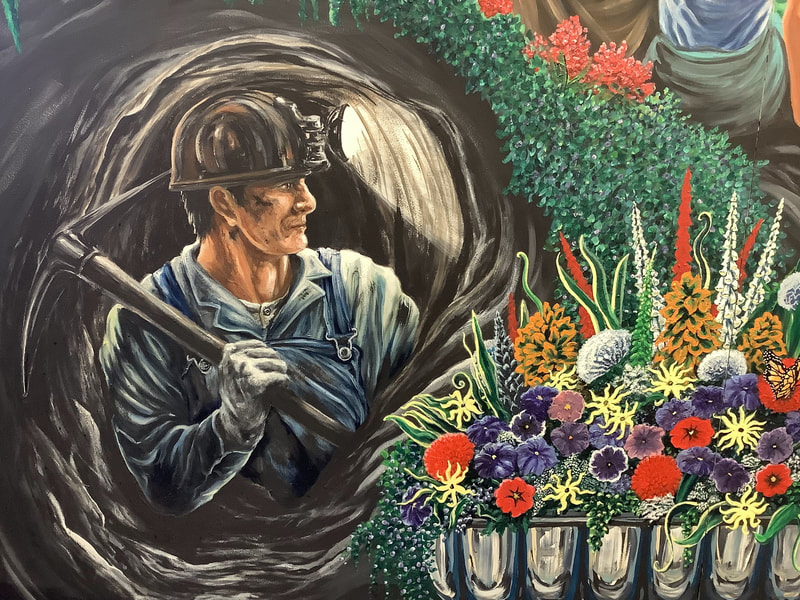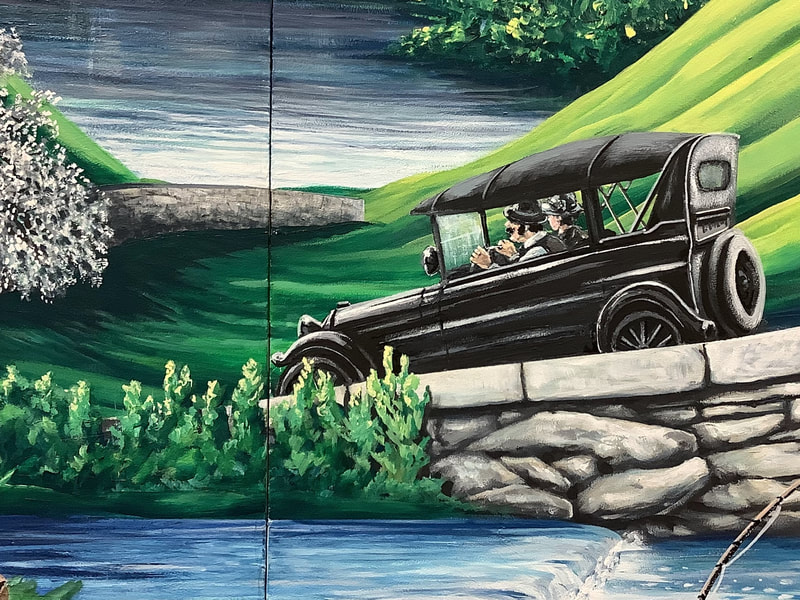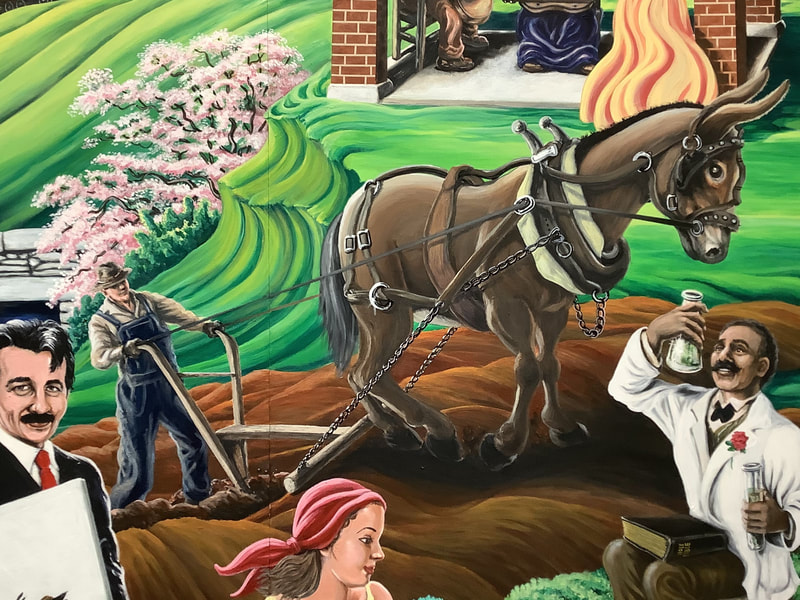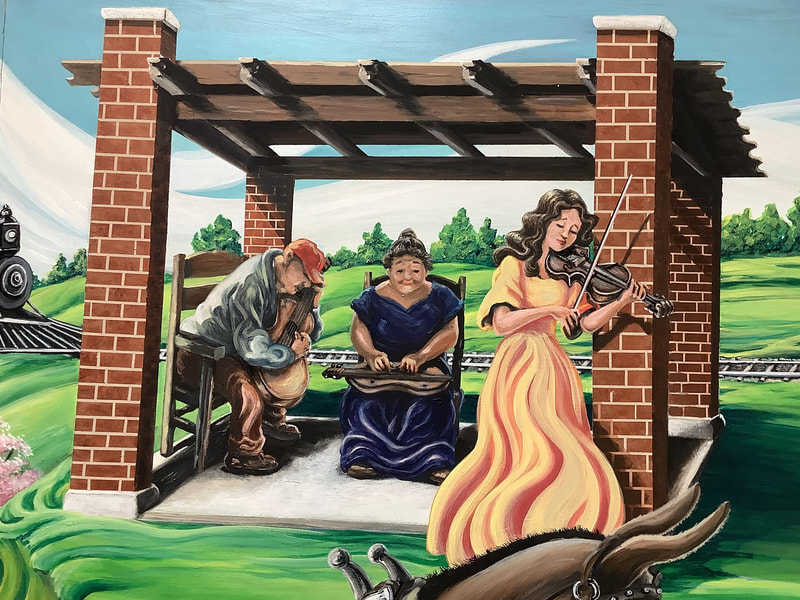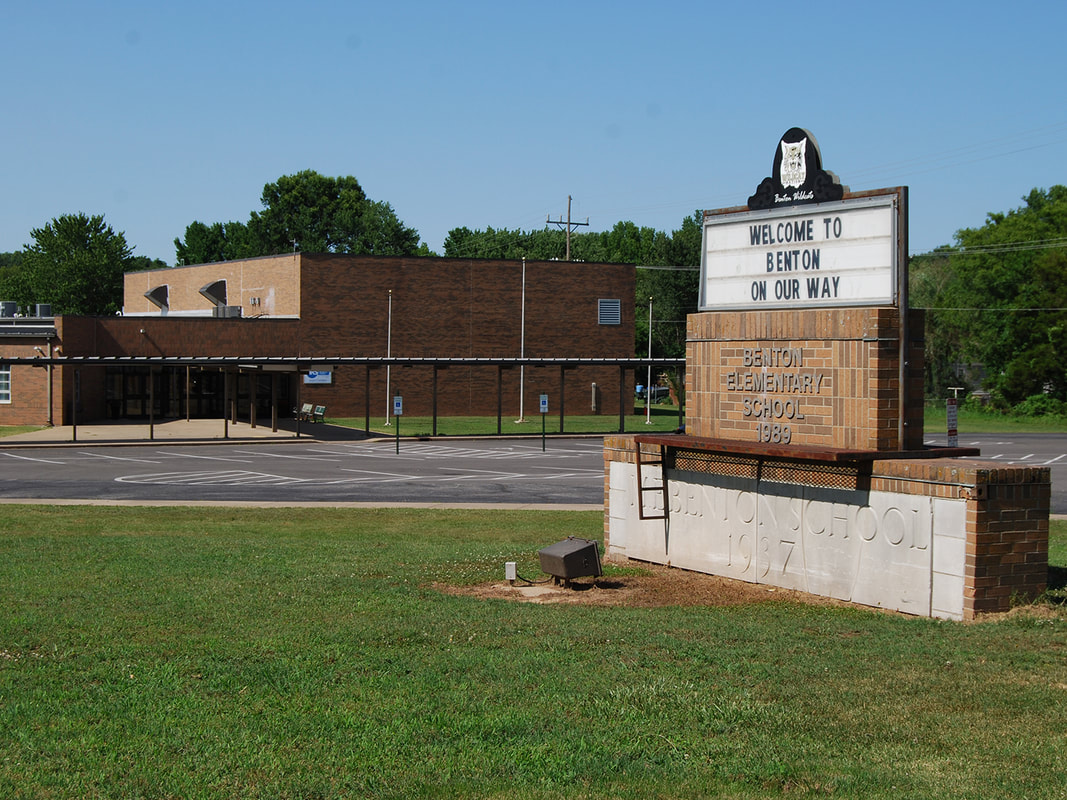Audio Description: Heritage by Sherry Pettey
Press play and discover Sherry Pettey's painting Heritage. Hear a detailed description of the artwork, descriptions of the colors and forms in the painting, and how the artist made the work. (Closed captions available on video.)
Heritage, Sherry Pettey, 2006, Acrylic on Panel
Read Transcript
Heritage is a 9 foot by 7 foot acrylic painting on three joined panels. It was painted in 2006 by Sherry Pettey.
The mural was painted in a style that resembles the work of regionalist painter Thomas Hart Benton. Many element of this work can be traced back to Benton’s paintings. The bright vibrant colors give life to the painting and invoke a feeling of spring. The bright blue sky with waving white clouds sits over lush green rolling hills that dominate the landscape.
The most prominent figure of the painting is famed regionalist painter Thomas Hart Benton who was born in Neosho in 1889. He’s seen in the middle of the foreground wearing a black suit with a red tie. Under his right arm he clutches a blank canvas and in his hand a bundle of paint brushes. He’s leaning against a walking stick in his left hand.
A steam engine train is seen in the background, just right of center, rushing up over the hills. The black engine is sending plums of black smoke in to the sky. Benton was known to have a life-long interest in trains and they are featured in many of his works.
In the middle ground to the right a man wearing blue overalls, a tan long sleeve shirt, and a brown hat is seen with a wood plow being drawn across the dark brown earth by a light brown mule wearing a harness. This reminds viewers that Benton’s work often showed the life of the working class.
In the upper left corner of the painting is a white two story house with a stone foundation obscured by five tall trees with dark brown trucks and vibrant green leaves. This represents the home in Neosho where Benton was born. The structure is obscured on purpose as the only known photo of the home was taken as it was burning down in 1917.
To the foreground of the house two children play around a water pump. A young boy, his back to the viewer, wears a yellow sleeveless top, blue jeans rolled up at the ankle, and no shoes. His left foot rests on a stone while he uses both hands to pump the lever of the red water pump. To his right a younger girl, facing the viewer, reaches her left hand into the pouring water. Her blond hair is tied back in pig tails with red ribbon that matches her dress.
To the left of center in the background stands a white Queen Anne style building with a brown roof and two asymmetrical square towers on either side of the building. This is the original home of the Neosho National Fish Hatchery which was established in 1888 and is still in operation today. A pond with rippling waters in white to dark blue gray sits in front of the building. This represents one of several ponds on the hatchery grounds where fish are raised.
In the very center of the painting, down from the hatchery building, a grey stone bridge arches over rushing white, blue, and dark blue water. This represents the spring that flows through Neosho’s Big Spring Park which was established in the very early 1900’s.
Across the spring waters, and closer to the viewer, a young boy wearing only a pair of rolled up blue jeans and a red hat stands proudly at the water’s edge holding a fishing pole over his pale right shoulder and a fish in his left hand.
A man in a black hat, white long sleeved shirt, and black waistcoat drives a black model T Ford to the left, over the bridge, and past a small water fall below. A woman in black dress with a matching hat sits in the passenger’s seat. They drive towards a flowering white dogwood tree.
To the right of the bridge, peaking between the green rolling hills, is a flowering pink dogwood tree in full bloom. This calls to mind Neosho's annual Dogwood Tour. In 1961, the Rotary Club initiated the Neosho Dogwood Tour which has brought thousands of guests to town to enjoy the tree's spring blooms.
In the far upper right corner of the painting is the red brick posts and wood rafters of the pergola which sits on the south east corner of the Newton County Courthouse lawn. An older man and women along with a younger woman have gathered to play music. On the left the man sits in ¾ profile in a ladder back chair wearing brown pants, a grey long sleeved shirt and a red hat. He is playing the guitar. Next to him on the right, a woman is seated. She is facing forwards in a floor length violet dress with short sleeves and resting a mountain dulcimer across her lap. Her fingers pluck at the strings while she looks up at the other woman. On the far right of the pergola a young woman, perhaps the couple’s daughter, stands. She has shoulder length wavy brown hair and is wearing a flowing yellow floor length dress with short sleeves. She’s playing the fiddle, her eyes closed and a content look upon her face. For decades the pergola has served as a stage for many gatherings of area musicians.
In the lower right corner of the painting are three figures.
To the left, a man and woman are working to harvest fruit from the strawberry fields. The woman on the left holds a wooden create full of picked strawberries in her arms, her hands in dark work gloves. She’s wearing a red bandana over her brown shoulder length hair, a yellow sleeveless top exposing her pale arms and shoulders, and a blue knee length skirt with a white apron over it. She is stepping up with her left foot, clad in a brown sandal with her red toe nail polish visible, on to the rocky embankment beside the lush green field of strawberry plants. Her gaze is turned to her left where a man is leaned over lifting another crate full of strawberries. He’s in ¾ profile from the back. His muscular torso is bare and he wears a yellow hat and blue jeans.
1897 saw the arrival of the strawberry industry and the first full train car holding 420, 24-quart crates shipped in 1899. Strawberries would become the area’s major crop until drought and labor shortages of the 1930’s diminished the industry. The State Horticultural Society held its Strawberry Congress in Neosho in 1913 and 1914 and local festivals were held annually in celebration of the crop.
To the right and above the pair, a man, George Washington Carver, sits turned to the left on a tree stump in a field of peanut plants. He wears a white lab coat with a red flower in the lapel over a brown suit with a black bow tie. Carver had a deep love for nature and was known to wear a fresh flower in his lapel daily. In his right hand he holds a beaker filled with green liquid up to eye level. His eyes are alight with discovery and a smile is across his face. A test tube filled with a sample is in his left hand. On his lap sits a Bible. He held a strong faith in God and that it was the only mechanism by which he could effectively pursue and perform the art of science. Born near Diamond, MO in 1864, Carver became one of the most prominent black scientists of the early 20th century. He was an agricultural scientist and professor at Tuskegee Institute. Carver developed over 300 products from the peanut plant leading him to speak during the national conference of the Peanut Growers Association in 1920 and to testify before Congress in 1921 to support the passage of a tariff on imported peanuts. This brought him wide publicity and increasing renown.
In the far left lower corner is a miner in a dark, rocky, tunnel. He’s looking to his left, the lamp on his helmet illuminating the dark surface on the mine where he works. He’s dressed in a dark work shirt with long sleeves and overalls. He holds a pickaxe over his right shoulder, his hand clad in a work glove. He represents the lead and zinc mining that took place across Newton County starting in 1847.
Above the miner on the surface are flowers in pink, blue, yellow, and purple amongst green foliage. To the right sits a couple, their backs to the viewer, on a large grey rock, their arms around one another. The man to the left wears a khaki US Army uniform with matching Garrison cap and a smile on his face. Beside him is a woman, her auburn hair styled in victory rolls. She wears a blue top with the sleeves rolled above her elbows and a green skirt that falls to her knees. They represent the many couples that spent time in the area during World War II when Camp Crowder was in operation just south of Neosho. Camp Crowder was established in 1941 and served as a U.S. Army Signal Corps replacement training center, an Army Service Forces training center and an officer candidate preparatory school, the first of its kind at any military installation. The 42,000 acre post also served as an infantry replacement center and had a prisoner of war camp.
Directly below the couple is a metal flower box filled with many colorful blooms of red, orange, yellow, purple, blue, and white. Neosho has been locally well-known as “The Flower Box City,” the name dubbed after the city earned the All-America City Award from Look magazine and the National Municipal League in 1957.
Heritage was commissioned in 2006 by the Newton County Tourism Council. The organization held a competition for designs for the purpose of creating large scale public works of art to increase tourism. The winner received a $1,000 prize and their work world be turned into a large scale painting. Pettey submitted a 22 x 28 inch painting to the competition. After her design was chosen, she elected to paint the large version herself. Since the work prominently features Neosho’s famed regionalist painter Thomas Hart Benton it was decided the painting should be displayed in the library of Benton Elementary School in Neosho, which was named for the artists father, U.S. Representative M.E. Benton.
The mural was painted in a style that resembles the work of regionalist painter Thomas Hart Benton. Many element of this work can be traced back to Benton’s paintings. The bright vibrant colors give life to the painting and invoke a feeling of spring. The bright blue sky with waving white clouds sits over lush green rolling hills that dominate the landscape.
The most prominent figure of the painting is famed regionalist painter Thomas Hart Benton who was born in Neosho in 1889. He’s seen in the middle of the foreground wearing a black suit with a red tie. Under his right arm he clutches a blank canvas and in his hand a bundle of paint brushes. He’s leaning against a walking stick in his left hand.
A steam engine train is seen in the background, just right of center, rushing up over the hills. The black engine is sending plums of black smoke in to the sky. Benton was known to have a life-long interest in trains and they are featured in many of his works.
In the middle ground to the right a man wearing blue overalls, a tan long sleeve shirt, and a brown hat is seen with a wood plow being drawn across the dark brown earth by a light brown mule wearing a harness. This reminds viewers that Benton’s work often showed the life of the working class.
In the upper left corner of the painting is a white two story house with a stone foundation obscured by five tall trees with dark brown trucks and vibrant green leaves. This represents the home in Neosho where Benton was born. The structure is obscured on purpose as the only known photo of the home was taken as it was burning down in 1917.
To the foreground of the house two children play around a water pump. A young boy, his back to the viewer, wears a yellow sleeveless top, blue jeans rolled up at the ankle, and no shoes. His left foot rests on a stone while he uses both hands to pump the lever of the red water pump. To his right a younger girl, facing the viewer, reaches her left hand into the pouring water. Her blond hair is tied back in pig tails with red ribbon that matches her dress.
To the left of center in the background stands a white Queen Anne style building with a brown roof and two asymmetrical square towers on either side of the building. This is the original home of the Neosho National Fish Hatchery which was established in 1888 and is still in operation today. A pond with rippling waters in white to dark blue gray sits in front of the building. This represents one of several ponds on the hatchery grounds where fish are raised.
In the very center of the painting, down from the hatchery building, a grey stone bridge arches over rushing white, blue, and dark blue water. This represents the spring that flows through Neosho’s Big Spring Park which was established in the very early 1900’s.
Across the spring waters, and closer to the viewer, a young boy wearing only a pair of rolled up blue jeans and a red hat stands proudly at the water’s edge holding a fishing pole over his pale right shoulder and a fish in his left hand.
A man in a black hat, white long sleeved shirt, and black waistcoat drives a black model T Ford to the left, over the bridge, and past a small water fall below. A woman in black dress with a matching hat sits in the passenger’s seat. They drive towards a flowering white dogwood tree.
To the right of the bridge, peaking between the green rolling hills, is a flowering pink dogwood tree in full bloom. This calls to mind Neosho's annual Dogwood Tour. In 1961, the Rotary Club initiated the Neosho Dogwood Tour which has brought thousands of guests to town to enjoy the tree's spring blooms.
In the far upper right corner of the painting is the red brick posts and wood rafters of the pergola which sits on the south east corner of the Newton County Courthouse lawn. An older man and women along with a younger woman have gathered to play music. On the left the man sits in ¾ profile in a ladder back chair wearing brown pants, a grey long sleeved shirt and a red hat. He is playing the guitar. Next to him on the right, a woman is seated. She is facing forwards in a floor length violet dress with short sleeves and resting a mountain dulcimer across her lap. Her fingers pluck at the strings while she looks up at the other woman. On the far right of the pergola a young woman, perhaps the couple’s daughter, stands. She has shoulder length wavy brown hair and is wearing a flowing yellow floor length dress with short sleeves. She’s playing the fiddle, her eyes closed and a content look upon her face. For decades the pergola has served as a stage for many gatherings of area musicians.
In the lower right corner of the painting are three figures.
To the left, a man and woman are working to harvest fruit from the strawberry fields. The woman on the left holds a wooden create full of picked strawberries in her arms, her hands in dark work gloves. She’s wearing a red bandana over her brown shoulder length hair, a yellow sleeveless top exposing her pale arms and shoulders, and a blue knee length skirt with a white apron over it. She is stepping up with her left foot, clad in a brown sandal with her red toe nail polish visible, on to the rocky embankment beside the lush green field of strawberry plants. Her gaze is turned to her left where a man is leaned over lifting another crate full of strawberries. He’s in ¾ profile from the back. His muscular torso is bare and he wears a yellow hat and blue jeans.
1897 saw the arrival of the strawberry industry and the first full train car holding 420, 24-quart crates shipped in 1899. Strawberries would become the area’s major crop until drought and labor shortages of the 1930’s diminished the industry. The State Horticultural Society held its Strawberry Congress in Neosho in 1913 and 1914 and local festivals were held annually in celebration of the crop.
To the right and above the pair, a man, George Washington Carver, sits turned to the left on a tree stump in a field of peanut plants. He wears a white lab coat with a red flower in the lapel over a brown suit with a black bow tie. Carver had a deep love for nature and was known to wear a fresh flower in his lapel daily. In his right hand he holds a beaker filled with green liquid up to eye level. His eyes are alight with discovery and a smile is across his face. A test tube filled with a sample is in his left hand. On his lap sits a Bible. He held a strong faith in God and that it was the only mechanism by which he could effectively pursue and perform the art of science. Born near Diamond, MO in 1864, Carver became one of the most prominent black scientists of the early 20th century. He was an agricultural scientist and professor at Tuskegee Institute. Carver developed over 300 products from the peanut plant leading him to speak during the national conference of the Peanut Growers Association in 1920 and to testify before Congress in 1921 to support the passage of a tariff on imported peanuts. This brought him wide publicity and increasing renown.
In the far left lower corner is a miner in a dark, rocky, tunnel. He’s looking to his left, the lamp on his helmet illuminating the dark surface on the mine where he works. He’s dressed in a dark work shirt with long sleeves and overalls. He holds a pickaxe over his right shoulder, his hand clad in a work glove. He represents the lead and zinc mining that took place across Newton County starting in 1847.
Above the miner on the surface are flowers in pink, blue, yellow, and purple amongst green foliage. To the right sits a couple, their backs to the viewer, on a large grey rock, their arms around one another. The man to the left wears a khaki US Army uniform with matching Garrison cap and a smile on his face. Beside him is a woman, her auburn hair styled in victory rolls. She wears a blue top with the sleeves rolled above her elbows and a green skirt that falls to her knees. They represent the many couples that spent time in the area during World War II when Camp Crowder was in operation just south of Neosho. Camp Crowder was established in 1941 and served as a U.S. Army Signal Corps replacement training center, an Army Service Forces training center and an officer candidate preparatory school, the first of its kind at any military installation. The 42,000 acre post also served as an infantry replacement center and had a prisoner of war camp.
Directly below the couple is a metal flower box filled with many colorful blooms of red, orange, yellow, purple, blue, and white. Neosho has been locally well-known as “The Flower Box City,” the name dubbed after the city earned the All-America City Award from Look magazine and the National Municipal League in 1957.
Heritage was commissioned in 2006 by the Newton County Tourism Council. The organization held a competition for designs for the purpose of creating large scale public works of art to increase tourism. The winner received a $1,000 prize and their work world be turned into a large scale painting. Pettey submitted a 22 x 28 inch painting to the competition. After her design was chosen, she elected to paint the large version herself. Since the work prominently features Neosho’s famed regionalist painter Thomas Hart Benton it was decided the painting should be displayed in the library of Benton Elementary School in Neosho, which was named for the artists father, U.S. Representative M.E. Benton.
Large Print Transcript
View Images
Mural Location
|
Benton Elementary School
Inside the school library 1120 Carl Sweeney Pkwy Neosho, MO 64850 Available for viewing during school hours after arranging an appointment by calling (417) 451-8610. |





